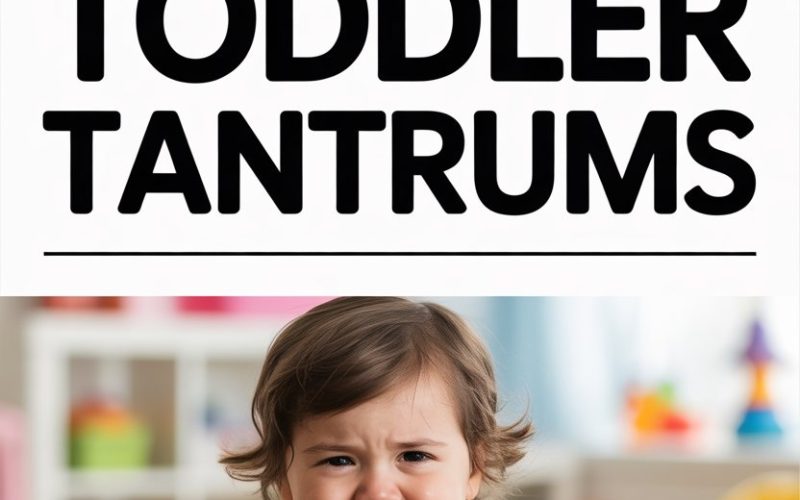Picture this: You’re standing in the supermarket, clutching an armful of bananas, when suddenly your sweet, chubby-cheeked cherub morphs into a howling banshee because you dared to put back the novelty marshmallow cereal.
Yes, welcome to the world of toddler tantrums—the emotional rollercoaster you didn’t queue up for.
If you’re reading this with bleary eyes and a pacifier in your pocket, you’re in the right place.
The Myth of the Tiny Dictator
A popular belief persists that tantrums are just proof your toddler is a tyrant in training. Not quite.
Tantrums happen because little children have enormous feelings but only a handful of words to express them.
Sometimes, they don’t even know what’s wrong—they just know something feels unfair, overwhelming, or different than expected. Were you aware that by age three, emotional regulation is still a work-in-progress?
In fact, research shows the part of the brain responsible for self-control isn’t fully online until the mid-twenties. Suddenly, the meltdown over the blue cup instead of the green one makes a bit more sense.
Tantrums Have a Life of Their Own
Once a tantrum is in motion, trying to halt it can feel like attempting to stop a freight train with a feather. You might believe there’s a magic phrase, a perfect snack, or a secret handshake that will instantly diffuse the situation.
Spoiler: There isn’t. Once the emotional volcano erupts, it needs to run its course.
That doesn’t mean you’re powerless. Your job isn’t to stop the tantrum at all costs, but to be the calm in your toddler’s storm.
Your presence and steadiness matter more than any clever distraction. As child psychologist Dr. Laura Markham notes, the parent’s job is to “share their calm, not join the chaos.”
Your toddler’s brain is learning about self-regulation by borrowing yours in these moments—even if all you feel like lending is a deep sigh and an internal scream.
Tantrums Aren’t a Reflection of Your Parenting
This one’s for anyone who’s ever felt the searing gaze of strangers as their child turns into a puddle of shrieks in the library. Tantrums do not mean you’re a bad parent.
Even the most patient, Pinterest-worthy mums and dads face them.
In fact, studies such as this one from the University of Washington found tantrums are a universal part of early childhood development, not a sign that something has gone wrong.
What helps: Instead of asking, “What did I do to cause this?” try “What does my child need right now?”
Sometimes the answer is a cuddle. Sometimes, it’s space. Sometimes, it’s just surviving until bedtime.
You Can’t Reason With a Tiny Tornado
After a certain age, you might feel tempted to explain, “We don’t eat crayons because they’re not food,” or “We can’t go to the zoo at 8pm because the meerkats are asleep.”
Logic is lovely—just not very effective when your little one’s brain is hijacked by big feelings.
Neuroscience reminds us that during intense emotional moments, the thinking part of the brain (the prefrontal cortex) is basically offline.
Trying to reason with a toddler mid-tantrum is like shouting instructions at a cat: it might make you feel better, but nobody’s listening.
Save your teaching moments for when everyone’s calm.
Your Own Emotions Will Surprise You
Parents are often blindsided by their own reactions. You may expect to feel sympathy or concern, but sometimes a tantrum brings out rage, embarrassment, or an overwhelming urge to run and hide behind the cereal display.
Feelings are contagious—yours included. Noticing your own emotions doesn’t make you weak, it makes you wise.
If you find yourself teetering on the edge, try the old reliable: deep breaths, count to ten, pretend you’re auditioning for a mindfulness podcast.
Your child is watching how you handle frustration, and that’s a pretty important lesson.
Prevention Is Worth a Pound of Rescue Vehicles
While tantrums can’t be eliminated, certain conditions make them more likely.
Ever tried to reason with a hungry, tired, or overstimulated toddler? It’s a bit like negotiating peace talks with a raccoon after it’s raided your bin.
Some parents swear by the HALT method: Hungry, Angry, Lonely, Tired. If one or more of those boxes is ticked, tantrum risk skyrockets.
You can hedge your bets by keeping snacks handy, planning outings after naps, and not squeezing one more errand into an already long day. The occasional curveball will still come your way, but at least you’ll have a fighting chance.
Connection Before Correction
It’s tempting to jump straight to “Stop that!” or “Big kids don’t scream in public.” Yet, research suggests that kids are much more receptive to guidance after they’ve felt heard and comforted.
Try getting down to their level, making eye contact, and acknowledging their feelings: “You’re really sad that we left the park. It’s hard when fun things end.”
This doesn’t mean giving in to every demand. It simply means showing your child that their feelings matter, even when the answer is still “no.”
As attachment researcher Dr. Daniel Siegel puts it, connecting before correcting helps children move through their emotions faster and with less drama.
The Art of the Strategic Ignore
Not all tantrums require a full-scale intervention. Sometimes, the best response is to step back (within safe limits, obviously) and allow your child to ride out their storm.
This doesn’t mean abandoning them emotionally; it means not feeding the drama with too much attention. If the tantrum is about not getting that extra biscuit, calmly remind them of the limit and then busy yourself with something else.
The less airtime a tantrum receives, the sooner it fizzles.
Public Tantrums: Survival Guide
A meltdown in the privacy of your lounge is one thing. When tantrums strike on a crowded bus, in the supermarket queue, or at a family function, even the most unflappable parent can feel like running for the hills.
For public displays, a few things help:
- Keep your voice low and calm, even if you’re quaking inside.
- Ignore judgmental looks; most people have been there.
- If possible, remove your child from the scene for a breather, but don’t feel you must flee in shame.
A sense of humour helps, too. You might even meet the eyes of another parent and share a wry smile. Solidarity is an excellent antidote to embarrassment.
You’ll Become a Tantrum Detective
Over time, you’ll start to notice patterns.
Does your child lose the plot if the routine changes? Are transitions hard? Perhaps hunger is the trigger, or maybe it’s a certain toy that causes more friction than it’s worth.
Keep mental (or actual) notes. Once you spot the trends, you can plan ahead or tweak your day to sidestep the biggest triggers.
If you notice tantrums are escalating in intensity, happening very frequently, or your child seems unable to calm down without hurting themselves or others, it may be time to check in with your GP or a child development specialist.
While these moments are common, your gut feeling is important, too.
Repair Is Everything
No parent handles every tantrum with zen-like patience. There will be times you lose your cool, say something you wish you hadn’t, or snap when you meant to soothe.
The good news: repair is a superpower.
After everyone’s calmed down, a quick apology and a cuddle go a long way. “I was frustrated and I yelled. Next time I’ll try to stay calmer. I love you.” You’re modelling real emotional skills—the kind your child needs for life.
Your Toddler’s Brain Is Doing Important Work
Tantrums, as aggravating as they are, are a sign of healthy development. Your child is testing boundaries, learning how to advocate for themselves, and working out what to do with enormous feelings.
When the dust settles, you’re laying the groundwork for emotional intelligence.
Research from Harvard’s Center on the Developing Child points out that these moments help build the neural pathways for self-regulation and resilience.
So while you might not feel thrilled as you wipe tears (yours and theirs) from your jumper, know that you’re helping your child’s brain grow stronger.
Tools for Your Tantrum Toolkit
A few practical tricks can ease the journey:
- Keep snacks and water handy whenever you go out.
- Use a calm-down space at home—somewhere cosy with a favourite soft toy or blanket.
- Practice naming emotions when everyone’s calm: “That made you angry, didn’t it?”
- Try simple distraction: “Do you see that silly bird outside?” (Not foolproof, but sometimes it works.)
- Use visual timers or sand timers to make transitions easier.
Apps like Moshi offer child-friendly meditations that can help little ones learn to settle, while Big Life Journal has resources for parents on building resilience.
The Light at the End of the Tunnel
It may feel endless now, but tantrums taper off as language skills, impulse control, and emotional understanding grow.
One day, you’ll realise it’s been weeks since the last full-blown meltdown. Don’t be surprised if you miss the drama—just a little.
Toddlers are complicated, squishy, loveable bundles of intensity. Their tantrums are wild, loud, and occasionally public, but they’re also a normal part of growing up.
If you find yourself clutching a banana while your child screams about cereal, remember that millions of parents stand with you (some of them hiding in the next aisle).
This too shall pass—possibly with a side of biscuits.





